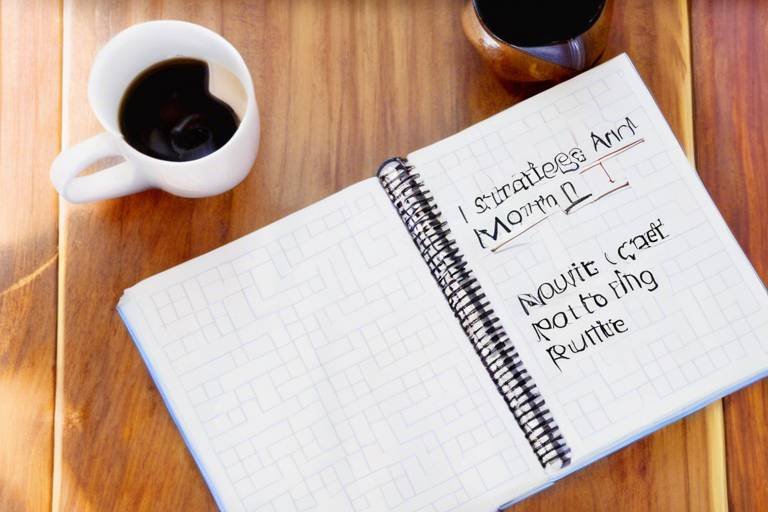Strategies to Create an Efficient Morning Routine
Creating an efficient morning routine can be a game changer for anyone looking to enhance their productivity and overall well-being. Imagine waking up each day feeling energized and ready to tackle whatever life throws at you. Sounds dreamy, right? Well, it’s entirely possible with the right strategies in place! By establishing a morning routine that resonates with your personal goals and lifestyle, you can set a positive tone for the rest of the day. Think of your morning as the launchpad for your daily mission; the way you start can significantly impact how you navigate through your tasks and challenges.
So, how do you craft this magical morning routine? It all starts with understanding the importance of a structured start to your day. Having a predictable sequence of activities can lead to improved mental clarity, reduced stress, and increased productivity. When you wake up and know exactly what you need to do, it eliminates the guesswork and helps you focus on what truly matters. Just like a well-oiled machine, a morning routine can streamline your day, making it smoother and more efficient.
But wait, let’s not rush into it! Before you dive into creating a routine, take a moment to assess your current morning habits. Are you a snooze-button champion? Or do you wake up and scroll through your phone for an hour? Identifying your existing patterns can help you pinpoint areas that need improvement. For instance, if you find yourself often rushing out the door, maybe you need to allocate more time for getting ready. It’s all about finding that sweet spot where your routine aligns with your lifestyle and goals.
Once you’ve got a handle on your current habits, it’s time to set some specific goals for your morning routine. This is where the magic really happens! By identifying what you want to achieve, you can tailor your routine to fit your needs perfectly. Are you looking to boost your energy levels? Maybe incorporating a quick workout or some stretching could do the trick. Or perhaps you want to enhance your mental clarity; in that case, a few minutes of meditation or journaling could be just what you need. The possibilities are endless!
Now, let’s talk about the difference between short-term and long-term goals. Short-term goals are like quick wins that can provide immediate motivation. For example, drinking a glass of water right after you wake up can kickstart your hydration for the day. On the other hand, long-term goals are more about the bigger picture. They require commitment and can lead to significant life changes over time. Think about developing a consistent meditation practice or improving your overall health. These long-term objectives will guide your daily actions and keep you focused on what truly matters in your life.
To make your morning routine as effective as possible, consider developing a structured plan. This will ensure that you stay consistent and make the most of your time each morning. Incorporating time management techniques, like time blocking or the Pomodoro method, can help you allocate specific time slots for each activity. For example, you could dedicate 30 minutes for exercise, followed by 15 minutes for breakfast, and then 10 minutes for planning your day. Having a clear structure in place can make your mornings feel less chaotic and more productive.
Lastly, prioritizing tasks in your morning routine is crucial. Not all activities hold the same weight in terms of importance. By identifying the most critical tasks, you can ensure that you focus on what truly matters each morning. Maybe you find that journaling helps clear your mind, or perhaps you feel more centered after a short meditation session. Whatever it is, make sure to prioritize those activities that contribute to your overall well-being and productivity.
- How long should my morning routine be? - Ideally, your morning routine should be long enough to include all the activities that help you feel energized and focused, usually between 30 minutes to 2 hours.
- Can I change my morning routine? - Absolutely! Your routine can evolve as your goals and lifestyle change. Feel free to adjust it as needed.
- What if I’m not a morning person? - Start small! Incorporate just one or two activities that you enjoy and gradually build from there.

Importance of a Morning Routine
Have you ever wondered why some people seem to glide through their mornings with ease while others struggle to get out of bed? The secret often lies in a well-crafted morning routine. Establishing a structured start to your day can be a game changer, offering a multitude of benefits that can enhance both your mental and physical well-being. A morning routine isn't just a series of tasks; it's a powerful tool that sets the tone for your entire day.
When you wake up and engage in a series of intentional activities, you're not just filling time before heading out the door. You're actively preparing your mind and body for the challenges that lie ahead. Think of your morning routine as a warm-up before a big game. Just as athletes need to stretch and focus before competing, you too can benefit from a period of preparation that primes you for success.
Here are some compelling reasons why a morning routine is essential:
- Mental Clarity: Starting your day with a routine can help clear your mind, making it easier to focus on tasks that require your attention.
- Increased Productivity: A structured morning allows you to prioritize your tasks, ensuring that you tackle the most important activities first.
- Enhanced Well-Being: Engaging in healthy habits, such as exercise or meditation, can boost your mood and overall mental health.
- Better Time Management: Having a set routine helps you manage your time more effectively, reducing the chaos that can come with a rushed morning.
Moreover, a morning routine can serve as a form of self-care, allowing you to invest in yourself before the world demands your attention. Imagine waking up, enjoying a peaceful cup of coffee, and taking a moment to reflect on your goals for the day. This simple act can create a profound sense of purpose and direction.
In addition, establishing a morning routine can help you develop a sense of discipline. When you commit to a series of activities each morning, you cultivate habits that can lead to long-term success. It’s like building a muscle; the more you practice, the stronger you become. Over time, these small, consistent actions can lead to significant changes in your life.
Ultimately, the importance of a morning routine lies in its ability to transform your day from chaotic to calm, from unfocused to purposeful. By dedicating time to yourself each morning, you lay the groundwork for a day filled with energy, clarity, and productivity. So, why not give it a try? You might just find that a simple morning routine can lead to extraordinary results in your life.

Identifying Your Goals
When it comes to establishing a morning routine, is like setting the compass for your day. Without clear objectives, you might find yourself wandering aimlessly through the morning, which can lead to frustration and a lack of productivity. Think of it this way: if you were planning a road trip, you wouldn't just hop in the car and drive without a destination, right? Similarly, having defined goals gives your morning direction and purpose.
So, what do you want to achieve in those precious early hours? It’s essential to take a moment to reflect on your personal aspirations. Are you looking to boost your energy levels, enhance your mental clarity, or perhaps carve out time for self-care? The beauty of a morning routine is that it can be tailored to fit your unique needs and desires. For instance, you might want to incorporate activities that resonate with your lifestyle, such as:
- Physical activity: This could be a quick workout, yoga, or even a brisk walk outside.
- Mindfulness practices: Meditation or journaling can help center your thoughts and prepare you mentally for the day ahead.
- Healthy nutrition: Fueling your body with a nutritious breakfast can set a positive tone for your day.
By pinpointing your goals, you can create a morning routine that not only energizes you but also aligns with your long-term aspirations. It’s like planting seeds in a garden; the more you understand what you want to grow, the better you can nurture those seeds into flourishing plants. Take the time to jot down your goals, both short-term and long-term, as this will serve as your roadmap. Short-term goals might include simple tasks like drinking a glass of water upon waking, while long-term goals could involve developing a consistent meditation practice or improving your overall health.
Remember, the key to a successful morning routine is not just about filling your time with activities; it’s about being intentional with those activities. By clearly identifying your goals, you set the stage for a morning that not only feels productive but also fulfilling. So, what are you waiting for? Grab a notebook, and start mapping out your morning aspirations today!

Short-term vs. Long-term Goals
When it comes to establishing a productive morning routine, understanding the difference between short-term and long-term goals is not just beneficial; it’s essential. Think of short-term goals as the stepping stones that lead you to your ultimate destination. These are the quick wins that can ignite your motivation and give you a sense of accomplishment right from the get-go. For instance, waking up and immediately drinking a glass of water can be a small yet powerful action that kickstarts your day. It’s like turning on a light switch in a dark room; suddenly, everything is clearer, and you’re ready to move forward.
On the other hand, long-term goals are akin to the grand vision you have for your life. They provide direction and purpose, guiding your daily actions and decisions. Imagine you want to develop a consistent meditation practice; this is a long-term goal that requires dedication and time. Unlike short-term goals, which can be achieved in a matter of minutes or hours, long-term goals often unfold over weeks, months, or even years. They require you to be patient and committed, but the rewards can be life-changing.
To illustrate the difference, let’s break it down further:
| Goal Type | Characteristics | Examples |
|---|---|---|
| Short-term Goals |
|
Drinking water, exercising for 10 minutes, journaling |
| Long-term Goals |
|
Building a daily meditation practice, improving fitness levels, learning a new language |
Both types of goals play a pivotal role in shaping your morning routine. While short-term goals can create a sense of achievement that fuels your motivation, long-term goals provide the framework that keeps you on track. Imagine trying to build a house without a blueprint; it would be chaotic and unproductive. Similarly, without long-term goals, your efforts can feel scattered and unfocused. By balancing both short-term and long-term goals, you can create a morning routine that not only energizes you for the day ahead but also aligns with your broader life aspirations.
So, as you think about your morning routine, ask yourself: What are the small wins I can achieve today? And how do these connect to my larger life goals? This dual approach will not only make your mornings more effective but also enrich your overall journey toward personal growth and fulfillment.
Q: How can I stay motivated to stick to my morning routine?
A: One effective way to stay motivated is to celebrate your short-term goals. Acknowledge your achievements, no matter how small, and remind yourself of the long-term vision that drives you. Also, consider finding an accountability partner to share your progress with.
Q: What if I miss a day in my routine?
A: It’s completely normal to have off days. The key is not to be too hard on yourself. Reflect on what caused the disruption and adjust your plan if necessary. Remember, consistency is important, but so is flexibility.
Q: How do I know if my goals are realistic?
A: Start by assessing your current habits and lifestyle. Set goals that challenge you but are still achievable. You can also utilize the SMART criteria—Specific, Measurable, Achievable, Relevant, Time-bound—to evaluate your goals effectively.

Examples of Short-term Goals
When it comes to creating an efficient morning routine, setting short-term goals is like laying the stepping stones on your path to success. These goals are typically achievable within a few days or weeks, providing you with a sense of accomplishment that can energize your day. Think of them as little victories that not only boost your confidence but also set a positive tone for your entire day.
For instance, one of the simplest short-term goals you can set is to drink a glass of water right after you wake up. This small act can hydrate your body and jumpstart your metabolism, making you feel refreshed and ready to tackle the day ahead. Similarly, incorporating a quick workout into your morning can serve as another fantastic short-term goal. Whether it’s a brief session of yoga, a 15-minute jog, or even some quick stretching exercises, getting your body moving first thing in the morning can invigorate your mind and enhance your focus.
Another great example of a short-term goal is to spend just 5 to 10 minutes journaling or planning your day. This practice helps you clarify your thoughts and prioritize your tasks, allowing you to approach your day with intention. You might also consider setting a goal to read a few pages of a book or listen to an inspiring podcast while you prepare breakfast. These activities can stimulate your mind and provide you with fresh ideas and motivation.
Moreover, if you’re looking to incorporate mindfulness into your morning, you could set a goal to meditate for just 5 minutes. This practice can help center your thoughts and reduce stress, making it easier to face the day’s challenges. Remember, the key here is to keep these goals manageable and rewarding. Achieving them can create a positive feedback loop that encourages you to continue building on your routine.
Here’s a quick recap of some effective short-term goals you might consider:
- Drink a glass of water upon waking
- Complete a quick workout (yoga, jogging, stretching)
- Spend 5-10 minutes journaling or planning your day
- Read a few pages of a book or listen to a podcast
- Meditate for 5 minutes
By focusing on these short-term goals, you not only set the stage for a successful morning but also pave the way for long-term achievements. Each small step contributes to a greater sense of well-being and productivity, making your mornings something you look forward to rather than dread.
Q: Why are short-term goals important in a morning routine?
A: Short-term goals provide immediate motivation and a sense of accomplishment, helping to build momentum for your day.
Q: How can I track my short-term goals?
A: You can use a journal, an app, or even a simple checklist to keep track of your goals and monitor your progress.
Q: Can short-term goals change over time?
A: Absolutely! As you achieve certain goals, feel free to modify them or set new ones to keep your morning routine fresh and engaging.

Examples of Long-term Goals
When it comes to establishing a morning routine, long-term goals serve as your guiding star. They are the dreams you aspire to achieve over time, providing a sense of direction and purpose. Think of them as the foundation upon which your daily habits are built. For instance, one popular long-term goal might be to develop a consistent meditation practice. Imagine waking up each day feeling centered and calm, ready to tackle whatever life throws your way. This isn’t just about sitting quietly; it's about cultivating a deeper connection with yourself, which can lead to improved focus and emotional resilience.
Another significant long-term goal could be enhancing your overall health. This might not just mean hitting the gym every day but embracing a holistic approach to well-being. You might strive to eat healthier, prioritize sleep, and incorporate regular exercise into your lifestyle. Think of your body as a car; without proper maintenance, it won't run smoothly. By setting this goal, you're committing to the long-term upkeep of your vehicle—your body—ensuring it runs efficiently and effectively.
Here are a few more examples of long-term goals that can enrich your morning routine:
- Improving Mental Health: This could involve regular journaling or practicing gratitude each morning, helping you cultivate a positive mindset.
- Building a Reading Habit: Setting a goal to read a certain number of books each year can stimulate your mind and expand your horizons.
- Learning a New Skill: Dedicating time each morning to learn a new language or an instrument can be both fulfilling and intellectually stimulating.
By integrating these long-term goals into your morning routine, you create a powerful framework for personal growth. It’s not just about the actions themselves; it’s about the transformation they bring to your life. Each small step you take in the morning contributes to these larger aspirations, making the journey toward your long-term goals both manageable and rewarding. So, as you outline your morning routine, consider how each element aligns with your bigger picture. This alignment will not only keep you motivated but will also make your mornings something to look forward to.
Q: How long does it take to establish a morning routine?
A: While it varies for everyone, research suggests that it can take anywhere from 21 to 66 days to form a new habit. Consistency is key!
Q: What if I struggle to wake up early?
A: Start by gradually adjusting your bedtime and wake-up time. Aim for just 15 minutes earlier each day until you reach your desired wake-up time.
Q: Can I customize my morning routine?
A: Absolutely! The best morning routine is one that fits your lifestyle and goals. Feel free to experiment and find what works best for you.
Q: What should I do if I miss a day in my routine?
A: Don’t be too hard on yourself! Missing a day is normal. Just get back on track the next day and remember that consistency over time is what matters most.

Assessing Your Current Routine
This article explores various strategies to establish a productive morning routine, helping you kickstart your day with energy and focus for enhanced productivity and well-being.
Understanding why a morning routine is essential can motivate you to create one. A structured start can lead to improved mental clarity and productivity throughout the day.
Setting specific goals for your morning routine can help tailor it to your needs. Identifying what you want to achieve allows for a more focused and effective start to your day.
Differentiating between short-term and long-term goals is crucial. Short-term goals can provide immediate motivation, while long-term goals guide your overall direction and purpose in establishing a routine.
Short-term goals might include drinking a glass of water upon waking or completing a quick workout. These small wins can boost your confidence and set a positive tone for the day.
Long-term goals could involve developing a consistent meditation practice or improving your overall health. These objectives require commitment and can significantly enhance your quality of life.
To create an efficient morning routine, it's vital to first assess your current habits. Think of your morning routine as a canvas; understanding what colors (or habits) you already have will help you decide what you want to add or change. Start by reflecting on how you currently spend your mornings. Are you rushing through breakfast, scrolling through your phone, or perhaps skipping essential activities altogether? Take a moment to jot down your typical morning activities. This could be as simple as:
- Waking up
- Checking emails or social media
- Brushing teeth and taking a shower
- Having breakfast
- Rushing out the door
Once you have a clear picture of your existing routine, ask yourself some critical questions: What activities energize you? Which ones drain your energy? Are there habits that consistently lead to a chaotic start? By pinpointing these aspects, you can identify areas for improvement. For instance, if scrolling through social media leaves you feeling anxious, consider replacing that time with a few minutes of stretching or reading.
Additionally, it might be helpful to track your current routine for a week. You can create a simple table to note the time spent on each activity. Here's a basic example:
| Activity | Time Spent (minutes) |
|---|---|
| Waking Up | 10 |
| Social Media Check | 15 |
| Breakfast | 20 |
| Getting Ready | 30 |
| Commute | 20 |
This table will help you visualize where your time is going. The goal is to find a balance between activities that invigorate you and those that may be time-wasters. Once you have this information, you can start to tweak your routine to focus more on what truly matters. Remember, the aim is to create a morning that sets a positive tone for the day ahead.
Developing a structured plan for your morning routine ensures consistency and effectiveness. A well-organized approach can help you streamline your activities and maximize your time.
Implementing time management techniques can enhance your morning routine. Techniques such as time blocking or the Pomodoro method can help allocate specific time slots for each activity.
Prioritizing tasks in your morning routine is essential for maximizing productivity. Identifying the most important activities ensures that you focus on what truly matters each morning.
Q: How long should my morning routine be?
A: The length of your morning routine can vary based on personal preference. However, aim for at least 30 minutes to an hour to incorporate essential activities without feeling rushed.
Q: What if I’m not a morning person?
A: If mornings are tough for you, start small! Gradually adjust your wake-up time and incorporate one new activity at a time until you find a routine that feels right.
Q: Can I change my routine later?
A: Absolutely! Your morning routine should evolve with your needs and lifestyle. Feel free to tweak it as you discover what works best for you.

Creating a Structured Plan
When it comes to establishing an efficient morning routine, is your secret weapon. Think of it as your roadmap; without it, you might find yourself wandering aimlessly through the morning fog. A structured plan not only helps you stay on track but also ensures that every minute of your morning is utilized effectively. Imagine waking up, knowing exactly what to do and when to do it. No more scrambling around or feeling rushed. Sounds good, right?
To kick things off, it's essential to define what a structured plan looks like for you. This can vary from person to person, but the core idea remains the same: you want to create a sequence of activities that align with your goals and priorities. Consider this: if you were to break down your morning into segments, what would those segments look like? Would you start with a refreshing shower, followed by a nourishing breakfast, and then dive into some exercise? Or perhaps you’d prefer to meditate first, allowing your mind to awaken gently before tackling the day. Whatever your preferences, the key is to design a plan that resonates with you.
One effective way to structure your morning is by allocating specific time slots for each activity. This is where time management techniques come into play. Techniques like time blocking can help you assign dedicated periods for each task. For instance, you might block off 30 minutes for exercise, 15 minutes for breakfast, and 10 minutes for journaling. By doing this, you create a sense of urgency and ensure that you’re not spending too long on any one activity, which can lead to chaos and disorganization.
To give you a clearer picture, here’s a simple example of what a structured morning plan might look like:
| Time | Activity |
|---|---|
| 6:00 AM - 6:30 AM | Morning Exercise |
| 6:30 AM - 6:45 AM | Shower and Get Dressed |
| 6:45 AM - 7:00 AM | Healthy Breakfast |
| 7:00 AM - 7:15 AM | Meditation or Mindfulness |
| 7:15 AM - 7:30 AM | Plan the Day Ahead |
By following a structured plan like this, you can ensure that you’re starting your day on a positive note. But remember, flexibility is key! Life can be unpredictable, and some mornings may not go as planned. It's perfectly okay to adjust your schedule as needed. The goal is not to create a rigid framework but to establish a routine that serves you and enhances your well-being.
Another vital aspect of creating a structured plan is prioritizing your tasks. This means identifying which activities are non-negotiable and which ones can be adjusted or even omitted if time doesn’t allow. For instance, if you find that meditation significantly boosts your focus but you’re short on time, you might choose to skip breakfast or opt for a quick smoothie instead. The idea is to ensure that the most important activities are prioritized, allowing you to maximize your productivity right from the start of your day.
In conclusion, creating a structured plan for your morning routine is about finding the right balance between discipline and flexibility. It’s about setting the stage for a day filled with energy and focus. So, take the time to map out your mornings, and don’t hesitate to tweak your plan as you discover what works best for you. Remember, the early bird gets the worm, but it’s the structured bird that catches it efficiently!
- How long should my morning routine be? - Ideally, your morning routine should last between 30 minutes to 2 hours, depending on your schedule and activities.
- What if I don't have time for a morning routine? - Start small! Even 10-15 minutes of focused activities can make a significant difference.
- Can I change my morning routine? - Absolutely! Your routine should evolve as your needs change. Feel free to experiment and adjust.

Time Management Techniques
Time management is the secret sauce that can transform your mornings from chaotic to calm. Imagine waking up, knowing exactly what you need to do and when—sounds dreamy, right? Well, it's entirely possible with the right techniques! One of the most effective strategies is time blocking. This method involves dividing your morning into distinct blocks of time, each dedicated to a specific task or activity. For instance, you might allocate 30 minutes for exercise, followed by 20 minutes for breakfast, and then 40 minutes for planning your day. By doing this, you create a clear roadmap for your morning, reducing the chance of distractions and procrastination.
Another popular technique is the Pomodoro method, which encourages focused work sessions followed by short breaks. Although it’s often used for productivity during work hours, it can also be adapted for your morning routine. For example, set a timer for 25 minutes to focus solely on a task—maybe reading or journaling—then take a 5-minute break to stretch or grab a glass of water. This not only keeps your mind fresh but also helps maintain your energy levels throughout the morning.
Additionally, consider using a daily planner or a digital calendar to map out your morning activities. This visual representation of your tasks can help you see how much time you have available and what needs to be prioritized. You can even create a simple table to outline your morning schedule:
| Time | Activity |
|---|---|
| 6:00 AM - 6:30 AM | Exercise |
| 6:30 AM - 7:00 AM | Shower and Get Ready |
| 7:00 AM - 7:30 AM | Breakfast |
| 7:30 AM - 8:00 AM | Plan the Day |
Remember, the key to effective time management is flexibility. Life happens, and sometimes your plans will be disrupted. Don't be too hard on yourself if you can’t stick to your schedule perfectly. Instead, focus on the progress you’re making and adjust your plan as needed. By incorporating these time management techniques into your morning routine, you’ll not only enhance your productivity but also cultivate a sense of calm and control over your day. So, why not give it a try? Your mornings will thank you!
- What is a morning routine? A morning routine is a set of activities you consistently perform each morning to prepare for the day ahead.
- Why is a morning routine important? A morning routine helps improve mental clarity, boosts productivity, and sets a positive tone for the day.
- How can I create my own morning routine? Start by identifying your goals, assessing your current habits, and implementing time management techniques to structure your mornings.
- What are some common morning routine activities? Common activities include exercise, meditation, journaling, and planning your day.
- How long should my morning routine be? The duration can vary based on personal preference, but a routine of 30 to 90 minutes is often effective.

Prioritizing Tasks
This article explores various strategies to establish a productive morning routine, helping you kickstart your day with energy and focus for enhanced productivity and well-being.
Understanding why a morning routine is essential can motivate you to create one. A structured start can lead to improved mental clarity and productivity throughout the day.
Setting specific goals for your morning routine can help tailor it to your needs. Identifying what you want to achieve allows for a more focused and effective start to your day.
Differentiating between short-term and long-term goals is crucial. Short-term goals can provide immediate motivation, while long-term goals guide your overall direction and purpose in establishing a routine.
Short-term goals might include drinking a glass of water upon waking or completing a quick workout. These small wins can boost your confidence and set a positive tone for the day.
Long-term goals could involve developing a consistent meditation practice or improving your overall health. These objectives require commitment and can significantly enhance your quality of life.
Analyzing your existing morning habits can reveal areas for improvement. Understanding what works and what doesn’t can help you optimize your routine for better outcomes.
Developing a structured plan for your morning routine ensures consistency and effectiveness. A well-organized approach can help you streamline your activities and maximize your time.
Implementing time management techniques can enhance your morning routine. Techniques such as time blocking or the Pomodoro method can help allocate specific time slots for each activity.
Prioritizing tasks in your morning routine is essential for maximizing productivity. Think of your morning as a blank canvas; how you fill it can define the rest of your day. Start by identifying the most important activities that will have the greatest impact on your goals. For instance, if your priority is to maintain physical health, incorporating a short workout or stretching session can be crucial. On the other hand, if mental clarity is your focus, dedicating time to meditation or journaling might take precedence.
To effectively prioritize, consider using the Eisenhower Matrix, which helps categorize tasks based on urgency and importance. Here’s a quick breakdown:
| Task Type | Description |
|---|---|
| Urgent and Important | Tasks that require immediate attention and align with your goals. |
| Important but Not Urgent | Tasks that contribute to long-term goals but can be scheduled for later. |
| Urgent but Not Important | Tasks that may seem pressing but do not significantly impact your goals. |
| Not Urgent and Not Important | Tasks that can be eliminated or delegated. |
By categorizing your tasks this way, you can focus on what truly matters each morning. For example, if you wake up and feel overwhelmed by a long to-do list, take a moment to identify tasks that fall into the 'Urgent and Important' category. These are the activities that should take precedence in your morning routine.
Ultimately, prioritizing tasks isn't just about productivity; it's about creating a morning routine that feels fulfilling and energizing. By consciously choosing what to focus on, you can transform your mornings from chaotic to calm, setting a positive tone for the rest of your day.
- What is the best way to start a morning routine? A good starting point is to identify your goals and choose a few key activities that align with those goals.
- How long should a morning routine be? Ideally, your morning routine should last between 30 minutes to 2 hours, depending on your schedule and preferences.
- Can I change my morning routine? Absolutely! Your routine can evolve as your goals and lifestyle change.
- What if I don’t have time for a morning routine? Even a 10-minute routine can be effective. Focus on one or two key activities that matter most to you.
Frequently Asked Questions
- Why is having a morning routine important?
Having a morning routine is crucial because it sets the tone for your entire day. Just like a good breakfast fuels your body, a structured morning routine fuels your mind. It helps improve mental clarity, boosts productivity, and can even enhance your overall well-being. Think of it as the foundation of a house; without it, everything else can feel shaky and unsteady.
- How can I identify my goals for my morning routine?
Identifying your goals starts with a little self-reflection. Ask yourself what you want to achieve each morning. Are you looking to feel more energized? Do you want to incorporate exercise? By pinpointing specific goals, like drinking a glass of water first thing or spending five minutes meditating, you can tailor your routine to meet your personal needs and aspirations.
- What are some examples of short-term and long-term goals?
Short-term goals are those quick wins that can give you an instant boost, like doing a short workout or reading a chapter of a book. Long-term goals, on the other hand, might involve committing to a daily meditation practice or working towards a healthier lifestyle. Both types of goals are essential, as short-term goals provide immediate motivation, while long-term goals help guide your overall direction.
- How can I assess my current morning routine?
To assess your current routine, take a step back and analyze what you do each morning. Keep a journal for a week to track your habits. Identify what works well and what feels like a drag. This insight will help you uncover areas for improvement and allow you to optimize your routine for better outcomes.
- What time management techniques can I use in my morning routine?
Time management techniques like time blocking or the Pomodoro method can be game-changers for your morning routine. Time blocking involves allocating specific time slots for each activity, ensuring you stay on track. The Pomodoro method, which breaks work into intervals with short breaks in between, can also help maintain your focus and energy levels.
- How do I prioritize tasks in my morning routine?
Prioritizing tasks is all about identifying what truly matters. Start by listing out everything you want to accomplish and then rank these tasks based on importance. Focus on high-priority activities first, ensuring that your most critical tasks get the attention they deserve. This way, even if you run short on time, you’ve already tackled what’s most essential.



















